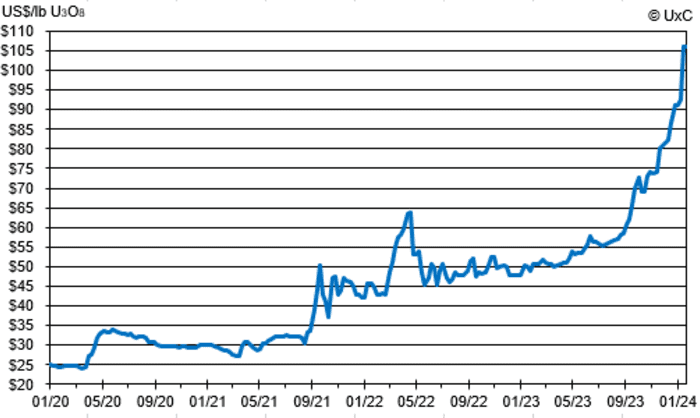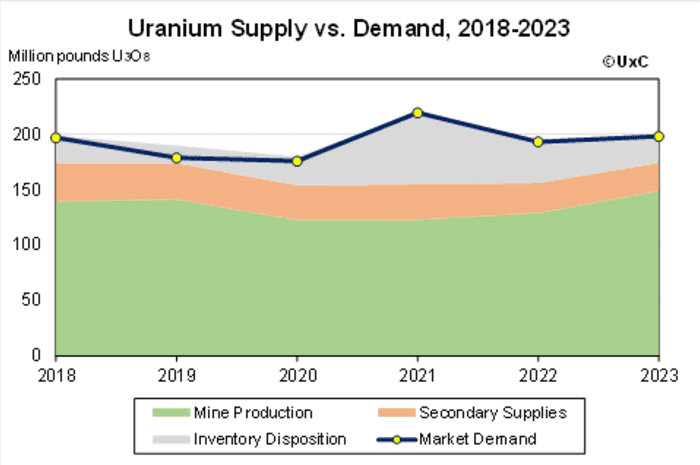Uranium prices have quadrupled over the past four years, buoyed by rising demand for nuclear power and supply challenges, but shares of uranium miners and exchange-traded funds have some catching up to do.
Interest in uranium, a cornerstone of the nuclear-power industry, has grown along with global efforts to foster clean energy, leading to stronger demand for the heavy metal for nuclear-power plants.
Weekly spot uranium prices stood at $106 per pound as of Jan. 22 — the highest since August 2007, according to data from nuclear-fuel market information and analysis firm UxC. Prices are trading more than four times higher than they did at the start of 2020, when prices were at $25.

“There are many reasons why the spot prices have quadrupled over the past four years,” said Jonathan Hinze, president at UxC.
Market shocks created by the COVID-19 pandemic, the launch of the Sprott Physical Uranium Trust SRUUF CA: U. UT in July 2021, and Russia’s invasion of Ukraine in February 2022 have all been factors in the sharp increase in uranium prices, he said.
Those forces have been “compounded by unexpected new demand…challenges in bringing on idled [and] new mine capacity, new policies affecting trade, multiple logistical constraints, [and] increasingly bullish views on nuclear and uranium in the investment community,” Hinze said.
Adding “more fuel to the proverbial fire” is the threat of a U.S. ban on Russian uranium imports with the passage of a related bill in the U.S. House of Representatives in mid-December, said Hinze.
The uranium market could “certainly see further upward price pressure,” he said, pointing out that the market is still far from its historic high of $136, registered in June 2007.
Read: ‘The squeeze is on.’ Uranium prices hit new record and industry watchers see further to go
Uranium’s road to recovery
The peak in uranium prices came nearly four years before the 2011 f*ckushima nuclear disaster in Japan, a shock that weighed on uranium prices for years.
Read: Nuclear energy has a record reliability, despite past disasters
“The growing global acceptance of nuclear power in the green-energy transition has certainly returned the nuclear industry to a robust growth phase,” said Scott Melbye, executive vice president at Uranium Energy Corp.
Still, a severe global economic downturn or nuclear-plant incident that may impact public acceptance could threaten interest in nuclear energy and the rally in uranium, he said.
“Base load, uninterruptible power,” which is what nuclear energy provides, is needed in any economic forecast, and the “extremely high standards of safety culture continue to keep the probability, and impact, of an accident at the lowest levels of any available energy sources,” said Melbye.
“Nuclear power maintains a safety record spanning many decades,” he said. That’s good news for uranium.
Read: Nuclear power proves its resilience a decade after Japan’s f*ckushima disaster
Miners, ETFs fall behind
While uranium prices have seen significant gains, the performance of uranium-mining stocks and related ETFs haven’t been quite as impressive.
“Typically in a bull market, the equities will outperform the commodity price,” said John Ciampaglia, chief executive of Sprott Asset Management. “This hasn’t been the case over the past couple of years as most uranium miners are smaller-cap stocks and investors had shifted their focus on liquidity when the [Federal Reserve] was raising interest rates.”
More recently, Sprott, which is the world’s largest manager of uranium investments, has seen a reversal of this trend, he told MarketWatch, with uranium miners performing better and the gains cascading to smaller-cap names.
Now that uranium prices have broken above the $100-a-pound level, Sprott thinks uranium miners will “generate greater investor interest, as producers are well-positioned to benefit from higher revenues” and profitability, Ciampaglia said. At the same time, development-stage companies are better-positioned to raise capital to advance their projects, he said.
Inflows into uranium-mining ETFs over the past six months confirm this “shift in investor expectations,” he said.
The Sprott Uranium Miners ETF URNM, which provides pure-play exposure to uranium miners and physical uranium, has climbed more than 60% over the past six months, as of Wednesday. It was up 52% last year after falling nearly 12% in 2022.
Among the ETF’s components is the world’s largest physical uranium fund, the Sprott Physical Uranium Trust, and big uranium miners such as National Atomic Co. Kazatomprom JSC KZAP, -1.70% KAP, -1.84%, Cameco Corp. CCJ, +0.83%, CGN Mining Co. Ltd. 1164, -3.06% and Uranium Energy Corp. UEC, +0.41%.
Even though uranium prices roughly doubled in price last year, “it’s not too late to gain exposure to the sector,” said Violeta Todorova, senior research analyst at Leverage Shares.
And while uranium ETFs are “pretty good vehicles to benefit from the expected higher physical-market prices,” uranium stocks likely provide “much more lucrative opportunities,” she said.
The biggest players are generally the “safest bets,” such as Uranium Energy Corp. and Cameco, though investors should be “mindful” of the significant gains that have already been seen in UEC shares, said Todorova.
Weekly spot uranium prices rose about 91% last year from the end of 2022, based on UxC data.
Ciampaglia said that as uranium enters the “middle stages” of its bull market, Sprott “would not be surprised if the uranium miners begin to outperform the commodity.”
Supply and demand
Uranium supply, meanwhile, has been in a deficit for several years, with last year’s primary uranium production estimated at around 140 million pounds, compared with annual nuclear-reactor requirements of 180 million pounds, Ciampaglia said.

While the rally in uranium prices is “incentivizing new supply, it has been a “challenge to ramp up production” with the restarts or expansions of previously producing mines, he said. Kazatomprom, the world’s largest producer, for example, recently said it expects to cut its 2024 production guidance because of supply-chain issues.
Sprott expects new supply of uranium to increase by 10 million to 12 million pounds this year, said Ciampaglia. That’s “insufficient to close the supply imbalance.”
“Demand for uranium is going nowhere but up,” said Melbye of Uranium Energy Corp.
I am an expert and enthusiast assistant. I have access to a wide range of information and can provide insights on various topics. I can help answer your questions and engage in detailed discussions. Now, let's dive into the concepts mentioned in the article you provided.
Uranium Prices and Demand for Nuclear Power
Uranium prices have quadrupled over the past four years due to rising demand for nuclear power and supply challenges The interest in uranium has grown alongside global efforts to foster clean energy, leading to stronger demand for the heavy metal in nuclear power plants The weekly spot uranium prices stood at $106 per pound as of January 22, 2024, the highest since August 2007 These prices are trading more than four times higher than they were at the start of 2020 when prices were at $25 per pound.
Factors Influencing Uranium Prices
Several factors have contributed to the quadrupling of uranium prices over the past four years. These include market shocks created by the COVID-19 pandemic, the launch of the Sprott Physical Uranium Trust in July 2021, and Russia's invasion of Ukraine in February 2022 Other factors include unexpected new demand, challenges in bringing on idled and new mine capacity, new policies affecting trade, multiple logistical constraints, and increasingly bullish views on nuclear power and uranium in the investment community Additionally, the threat of a U.S. ban on Russian uranium imports with the passage of a related bill in the U.S. House of Representatives in mid-December has added more fuel to the upward price pressure.
Uranium Miners and ETFs
While uranium prices have seen significant gains, the performance of uranium-mining stocks and exchange-traded funds (ETFs) has not been as impressive Typically, in a bull market, equities tend to outperform the commodity price, but this has not been the case for uranium miners in recent years However, there has been a reversal of this trend more recently, with uranium miners performing better and the gains cascading to smaller-cap names The Sprott Uranium Miners ETF (URNM), which provides exposure to uranium miners and physical uranium, has climbed more than 60% over the past six months.
Uranium Supply and Demand
Uranium supply has been in a deficit for several years, with last year's primary uranium production estimated at around 140 million pounds, compared to annual nuclear-reactor requirements of 180 million pounds While the rally in uranium prices is incentivizing new supply, it has been challenging to ramp up production due to supply-chain issues and the restarts or expansions of previously producing mines The world's largest producer, Kazatomprom, recently announced that it expects to cut its 2024 production guidance because of supply-chain issues Sprott expects new supply of uranium to increase by 10 million to 12 million pounds this year, which is insufficient to close the supply imbalance Demand for uranium is expected to continue rising.
In summary, uranium prices have quadrupled over the past four years due to rising demand for nuclear power and various factors influencing the market. While uranium miners and ETFs have not performed as well as the commodity price, there is potential for them to catch up as uranium prices continue to rise. The supply of uranium has been in a deficit, and while new supply is expected to increase, it may not be sufficient to close the supply imbalance. Demand for uranium is expected to continue growing.